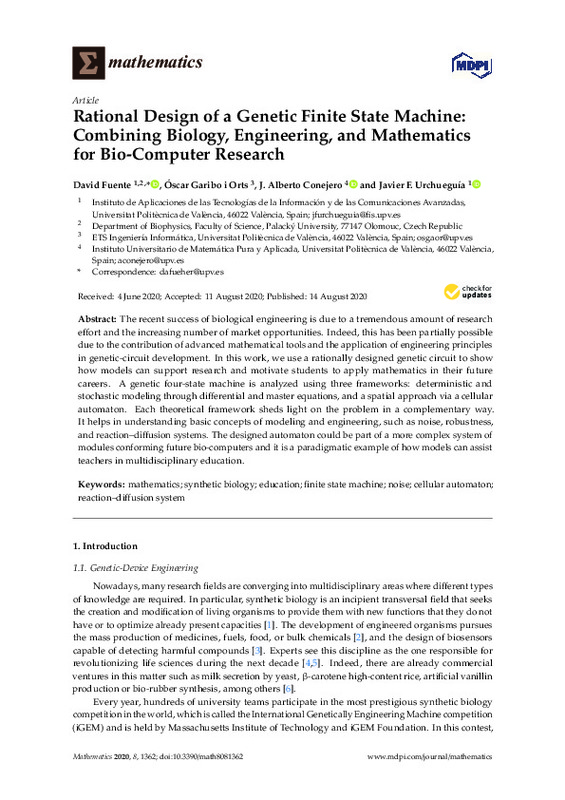Khalil, A. S., & Collins, J. J. (2010). Synthetic biology: applications come of age. Nature Reviews Genetics, 11(5), 367-379. doi:10.1038/nrg2775
Jullesson, D., David, F., Pfleger, B., & Nielsen, J. (2015). Impact of synthetic biology and metabolic engineering on industrial production of fine chemicals. Biotechnology Advances, 33(7), 1395-1402. doi:10.1016/j.biotechadv.2015.02.011
Bereza-Malcolm, L. T., Mann, G., & Franks, A. E. (2014). Environmental Sensing of Heavy Metals Through Whole Cell Microbial Biosensors: A Synthetic Biology Approach. ACS Synthetic Biology, 4(5), 535-546. doi:10.1021/sb500286r
[+]
Khalil, A. S., & Collins, J. J. (2010). Synthetic biology: applications come of age. Nature Reviews Genetics, 11(5), 367-379. doi:10.1038/nrg2775
Jullesson, D., David, F., Pfleger, B., & Nielsen, J. (2015). Impact of synthetic biology and metabolic engineering on industrial production of fine chemicals. Biotechnology Advances, 33(7), 1395-1402. doi:10.1016/j.biotechadv.2015.02.011
Bereza-Malcolm, L. T., Mann, G., & Franks, A. E. (2014). Environmental Sensing of Heavy Metals Through Whole Cell Microbial Biosensors: A Synthetic Biology Approach. ACS Synthetic Biology, 4(5), 535-546. doi:10.1021/sb500286r
Katz, L., Chen, Y. Y., Gonzalez, R., Peterson, T. C., Zhao, H., & Baltz, R. H. (2018). Synthetic biology advances and applications in the biotechnology industry: a perspective. Journal of Industrial Microbiology and Biotechnology, 45(7), 449-461. doi:10.1007/s10295-018-2056-y
Matheson, S. (2017). Engineering a Biological Revolution. Cell, 168(3), 329-332. doi:10.1016/j.cell.2017.01.001
Clarke, L., & Kitney, R. (2020). Developing synthetic biology for industrial biotechnology applications. Biochemical Society Transactions, 48(1), 113-122. doi:10.1042/bst20190349
Huynh, L., & Tagkopoulos, I. (2014). Optimal Part and Module Selection for Synthetic Gene Circuit Design Automation. ACS Synthetic Biology, 3(8), 556-564. doi:10.1021/sb400139h
McDaniel, R., & Weiss, R. (2005). Advances in synthetic biology: on the path from prototypes to applications. Current Opinion in Biotechnology, 16(4), 476-483. doi:10.1016/j.copbio.2005.07.002
Andrianantoandro, E., Basu, S., Karig, D. K., & Weiss, R. (2006). Synthetic biology: new engineering rules for an emerging discipline. Molecular Systems Biology, 2(1). doi:10.1038/msb4100073
Tyson, J. J., Chen, K. C., & Novak, B. (2003). Sniffers, buzzers, toggles and blinkers: dynamics of regulatory and signaling pathways in the cell. Current Opinion in Cell Biology, 15(2), 221-231. doi:10.1016/s0955-0674(03)00017-6
Wolfram, S. (1983). Statistical mechanics of cellular automata. Reviews of Modern Physics, 55(3), 601-644. doi:10.1103/revmodphys.55.601
Gardner, M. (1970). Mathematical Games. Scientific American, 223(4), 120-123. doi:10.1038/scientificamerican1070-120
Bybee, R. W. (2010). What Is STEM Education? Science, 329(5995), 996-996. doi:10.1126/science.1194998
Swaid, S. I. (2015). Bringing Computational Thinking to STEM Education. Procedia Manufacturing, 3, 3657-3662. doi:10.1016/j.promfg.2015.07.761
Dai, T., & Cromley, J. G. (2014). Changes in implicit theories of ability in biology and dropout from STEM majors: A latent growth curve approach. Contemporary Educational Psychology, 39(3), 233-247. doi:10.1016/j.cedpsych.2014.06.003
Willaert, S. S. ., de Graaf, R., & Minderhoud, S. (1998). Collaborative engineering: A case study of Concurrent Engineering in a wider context. Journal of Engineering and Technology Management, 15(1), 87-109. doi:10.1016/s0923-4748(97)00026-x
Machado, D., Costa, R. S., Rocha, M., Ferreira, E. C., Tidor, B., & Rocha, I. (2011). Modeling formalisms in Systems Biology. AMB Express, 1(1), 45. doi:10.1186/2191-0855-1-45
Rojo Robas, V., Madariaga, J. M., & Villarroel, J. D. (2020). Secondary Education Students’ Beliefs about Mathematics and Their Repercussions on Motivation. Mathematics, 8(3), 368. doi:10.3390/math8030368
Schlitt, T., & Brazma, A. (2007). Current approaches to gene regulatory network modelling. BMC Bioinformatics, 8(S6). doi:10.1186/1471-2105-8-s6-s9
Karlebach, G., & Shamir, R. (2008). Modelling and analysis of gene regulatory networks. Nature Reviews Molecular Cell Biology, 9(10), 770-780. doi:10.1038/nrm2503
Casini, A., Storch, M., Baldwin, G. S., & Ellis, T. (2015). Bricks and blueprints: methods and standards for DNA assembly. Nature Reviews Molecular Cell Biology, 16(9), 568-576. doi:10.1038/nrm4014
Appleton, E., Madsen, C., Roehner, N., & Densmore, D. (2017). Design Automation in Synthetic Biology. Cold Spring Harbor Perspectives in Biology, 9(4), a023978. doi:10.1101/cshperspect.a023978
Selberg, J., Gomez, M., & Rolandi, M. (2018). The Potential for Convergence between Synthetic Biology and Bioelectronics. Cell Systems, 7(3), 231-244. doi:10.1016/j.cels.2018.08.007
Britton, N. F., Bulai, I. M., Saussure, S., Holst, N., & Venturino, E. (2019). Can aphids be controlled by fungus? A mathematical model. Applied Mathematics and Nonlinear Sciences, 4(1), 79-92. doi:10.2478/amns.2019.1.00009
Rojas, C., & Belmonte-Beitia, J. (2018). Optimal control problems for differential equations applied to tumor growth: state of the art. Applied Mathematics and Nonlinear Sciences, 3(2), 375-402. doi:10.21042/amns.2018.2.00029
Tsimring, L. S. (2014). Noise in biology. Reports on Progress in Physics, 77(2), 026601. doi:10.1088/0034-4885/77/2/026601
Székely, T., & Burrage, K. (2014). Stochastic simulation in systems biology. Computational and Structural Biotechnology Journal, 12(20-21), 14-25. doi:10.1016/j.csbj.2014.10.003
Bessonov, N., Bocharov, G., Meyerhans, A., Popov, V., & Volpert, V. (2020). Nonlocal Reaction–Diffusion Model of Viral Evolution: Emergence of Virus Strains. Mathematics, 8(1), 117. doi:10.3390/math8010117
Mealy, G. H. (1955). A method for synthesizing sequential circuits. The Bell System Technical Journal, 34(5), 1045-1079. doi:10.1002/j.1538-7305.1955.tb03788.x
Marchisio, M. A. (2014). Parts & Pools: A Framework for Modular Design of Synthetic Gene Circuits. Frontiers in Bioengineering and Biotechnology, 2. doi:10.3389/fbioe.2014.00042
Stefan, M. I., & Le Novère, N. (2013). Cooperative Binding. PLoS Computational Biology, 9(6), e1003106. doi:10.1371/journal.pcbi.1003106
Elowitz, M. B., Levine, A. J., Siggia, E. D., & Swain, P. S. (2002). Stochastic Gene Expression in a Single Cell. Science, 297(5584), 1183-1186. doi:10.1126/science.1070919
Gillespie, D. T. (1977). Exact stochastic simulation of coupled chemical reactions. The Journal of Physical Chemistry, 81(25), 2340-2361. doi:10.1021/j100540a008
Gillespie, D. T. (1976). A general method for numerically simulating the stochastic time evolution of coupled chemical reactions. Journal of Computational Physics, 22(4), 403-434. doi:10.1016/0021-9991(76)90041-3
Gillespie, D. T. (2007). Stochastic Simulation of Chemical Kinetics. Annual Review of Physical Chemistry, 58(1), 35-55. doi:10.1146/annurev.physchem.58.032806.104637
Railsback, S. F., Lytinen, S. L., & Jackson, S. K. (2006). Agent-based Simulation Platforms: Review and Development Recommendations. SIMULATION, 82(9), 609-623. doi:10.1177/0037549706073695
TURING, A. (1990). The chemical basis of morphogenesis. Bulletin of Mathematical Biology, 52(1-2), 153-197. doi:10.1016/s0092-8240(05)80008-4
Henkel, J., Wolf, W., & Chakradhar, S. (s. f.). On-chip networks: a scalable, communication-centric embedded system design paradigm. 17th International Conference on VLSI Design. Proceedings. doi:10.1109/icvd.2004.1261037
[-]









